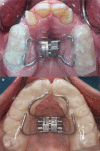Differential Benefit of Two Different Tooth-Borne Rapid Maxillary Expansion Appliances in Female Subjects
- PMID: 30206564
- PMCID: PMC6124886
- DOI: 10.5152/TurkJOrthod.2018.17051
Differential Benefit of Two Different Tooth-Borne Rapid Maxillary Expansion Appliances in Female Subjects
Abstract
Objective: The aim of the present study was to evaluate the effects of tooth-borne acrylic-bonded rapid maxillary expansion (RME) appliances with or without the anterior teeth anchorage on the skeletal and dentoalveolar structures, as well as soft tissues.
Methods: This study included 44 patients who were treated with two different tooth-borne bonded acrylic RME appliances. Lateral cephalometric radiographs were taken before the treatment (T0) and in the post-retention (T1) phase of the RME treatment. The posterior-bonded RME appliance group and full-bonded RME appliance group were created as the two different groups of treatment. The following statistical analyses were performed: intra- and inter-group comparisons were made using the paired t-test, Wilcoxon test, independent t-test, and Mann-Whitney U-test for normal and non-normal distribution data.
Results: Significant increases were observed in R1-A, R1-ANS, R1-U1, R1-AR, R1-St, R1-Li, and R1-Pn in both groups. R1-PNS, R1-Ls, R1-Sn, and R1-B' were found to be significantly larger at T1 than at T0 in the posterior-bonded RME appliance group. R2-A, R2-ANS, R2-L1, R2-A', and R2-Pn were significantly larger at T1 than at T0 in the full-bonded RME appliance group. The R2-A' was significantly different between the groups.
Conclusion: The soft tissue A point appears to be the most important differing matter between the two different RME appliances, and a full acrylic-bonded RME appliance may be beneficial for subjects with a maxillary retrognathic profile.
Keywords: Rapid maxillary expansion; growing subjects; soft tissue profile; tooth-borne expander.
Conflict of interest statement
Conflict of Interest: No conflict of interest was declared by the authors.
Figures


References
-
- Lux CJ, Conradt C, Burden D, Komposch G. Dental arch widths and mandibular-maxillary base widths in Class II malocclusions between early mixed and permanent dentitions. Angle Orthod. 2003;73:674–85. - PubMed
-
- Angell EC. Irregularities of teeth and their treatment. San Francisco Medical Press. 1860:181–5.
-
- Haas AJ. Rapid Expansion of the Maxillary Dental Arch and Nasal Cavity by Opening the Midpalatal Suture. Angle Orthod. 1961;32:73–89.
LinkOut - more resources
Full Text Sources
Other Literature Sources
Research Materials
